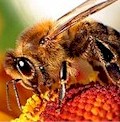The most important part of beekeeping is to do with the hive itself because it's where the colony spends the majority of its time. The biggest chore in beekeeping used to be removing the honey from the hive. But thanks to substantial improvements in beekeeping, this task is now far less difficult.
The Langstroth is the most widespread and commonly used beekeeping hive in the United States and is the standard around the world. It's what is known as a "movable frame" beehive and the support framework of the Langstroth hive is a wooden, rectangular in shape, and holds the combs inside. Generally, there are up to ten of these combs within the frame at any one time. The combs within the frame will hang on their own as the frames don't actually have a top or bottom; something that is quite amazing to see. The combs are constructed of a sheet of wax or can be plastic. These wax sheets are used as a starting point for the bees to then create further wax to build the honeycomb. Once complete, the bees will then deposit the honey and pollen into the cells of the comb. The box is made to accommodate the removal of frames that are saturated with the honey that needs to be extracted.
On the African continent, top-bar hives are in very common usage. Top-bar hives are also becoming more widespread in the United States for beekeepers who keep a hive as a hobby. The framework of top-bar hives comprises of bars running along the top. The bees then take advantage of these bars by hanging the combs from them. Unlike the frames that can be used again and again in a Langstroth hive, the combs used in top-bar hives can only be used the one time only. This design is not conducive to the production of honey in high volumes. "Why would one use a top-bar hive then?" you may ask. Because the honey that they produce is the highest quality honey that money can buy - and a tidy profit can be had.
But the kind of hive you end up purchasing is just one of the decisions you need to make when you're thinking of keeping bees on your property. Before the beekeeper even makes the decision to keep bees on their property, the proper research of local restrictions in regards to keeping bees in their area should be undertaken. The amount of space that is available and the where in that space, the hive should go is also quite important. The last place a beekeeper should place their hive is close by other homes, a school or a place that has a lot of foot traffic. Some people find bees vexing, particularly for those who are known to suffer allergies to the sting of a bee. It's advised to place a beehive close to where the bees can easily get to a food source. In some cases, beekeepers use their bees purely to pollinate their crops. Also, the bees will require fresh water, whether it's a natural source or is given to them by the beekeeper. Another key factor to the correct placement of a bee hive will come down to known animals in the area of a predatory nature such as bears, skunks and raccoons. Vandals can also be an issue when there is the potential for "free" honey. The hive will also need protection from harsh weather conditions but be easily accessible at all times. Beekeeping is a fulltime hobby, even if the bees are out and about during a certain parts of the year.
